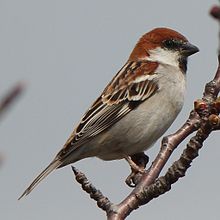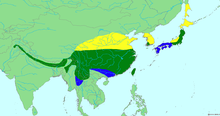
Back عصفور خمري Arabic Passer rutilans AST लाल गौरइया Bihari প্যাসার রুটিলানস Bengali/Bangla Pardal rutilant Catalan Passer rutilans CEB Vrabec rezavý Czech Golfan gwinau Asia Welsh Rødbrun spurv Danish Ruĝa pasero Esperanto
| Russet sparrow | |
|---|---|

| |

| |
| Male (above) and female (below) in Aichi Prefecture, Japan | |
| Scientific classification | |
| Domain: | Eukaryota |
| Kingdom: | Animalia |
| Phylum: | Chordata |
| Class: | Aves |
| Order: | Passeriformes |
| Family: | Passeridae |
| Genus: | Passer |
| Species: | P. cinnamomeus
|
| Binomial name | |
| Passer cinnamomeus (Gould, 1836)
| |

| |
| Distribution of russet sparrow:
Summer range
Winter range
Year-round range
| |
| Synonyms | |
The russet sparrow (Passer cinnamomeus), also called the cinnamon or cinnamon tree sparrow, is a passerine bird of the sparrow family Passeridae. A chunky little seed-eating bird with a thick bill, it has a body length of 14 to 15 cm (5.5–5.9 in). Its plumage is mainly warm rufous above and grey below. It exhibits sexual dimorphism, with the plumage of both sexes patterned similarly to that of the corresponding sex of house sparrow. Its vocalisations are sweet and musical chirps, which when strung together form a song.
Three subspecies are recognised, differing chiefly in the yellowness of their underparts. The subspecies rutilans and intensior breed in parts of eastern Asia, where they are usually found in light woodland, and the subspecies cinnamomeus breeds in the Himalayas, where it is usually associated with terrace cultivation. The russet sparrow is the typical sparrow of human habitations in towns where the house and Eurasian tree sparrows are absent. In the southern part of its range, the russet sparrow prefers higher altitudes, but in the north it breeds by the sea. The russet sparrow is known well enough in the Himalayas to have a distinct name in some languages, and is depicted in Japanese art.
This sparrow feeds mainly on the seeds of herbs and grains, but it also eats berries and insects, particularly during the breeding season. This diet makes it a minor pest in agricultural areas, but also a predator of insect pests. While breeding, it is not social, as its nests are dispersed. It forms flocks when not breeding, although it associates with other bird species infrequently. In some parts of its range, the russet sparrow migrates, at least to lower altitudes. Its nest is located in a tree cavity, or a hole in a cliff or building. The male chooses the nest site before finding a mate and uses the nest for courtship display. The typical clutch contains five or six whitish eggs. Both sexes incubate and feed the young.
- ^ BirdLife International (2016). "Passer cinnamomeus". IUCN Red List of Threatened Species. 2016: e.T22718191A94571752. doi:10.2305/IUCN.UK.2016-3.RLTS.T22718191A94571752.en. Retrieved 12 November 2021.
